Merycoidodon
| Merycoidodon Temporal range: Late Eocene–Late Oligocene | |
|---|---|
| | |
| Merycoidodon skeleton at Canadian Museum of Nature, Ottawa, Canada | |
| Scientific classification | |
| Kingdom: | Animalia |
| Phylum: | Chordata |
| Class: | Mammalia |
| Order: | Artiodactyla |
| Family: | †Merycoidodontidae |
| Subfamily: | †Merycoidodontinae |
| Genus: | †Merycoidodon Leidy, 1848 |
| Type species | |
| †Merycoidodon culbertsoni | |
| Subgenera and Species[1] | |
|
†Merycoidodon
†Otarohyus
unassigned
| |
| Synonyms | |
| |
Merycoidodon ("ruminating teeth") is an extinct genus of terrestrial herbivore of the family Merycoidodontidae, subfamily Merycoidodontinae (oreodont), more popularly known by the name Oreodon ("hillock teeth") endemic to North America during the Late Eocene-Early Miocene subepochs (38—16.3 mya) existing for approximately 21.7 million years.[2]
Taxonomy
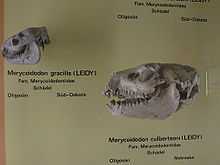
Merycoidodon was named by Leidy (1848). Its type is Merycoidodon culbertsoni. It was considered a nomen nudum by Cope (1884); it was considered a nomen dubium by Sinclair (1924); it was considered a nomen vanum by Lander (1998). It was assigned to Merycoidodontidae by Joseph Leidy (1848), Thorpe (1937), Scott (1940), Galbreath (1953), Toohey (1959) and Stevens and Stevens (1996).[3][4]
Most researchers in paleobiology and paleontology, however, now use the antecedent genus Merycoidodon to refer to this Oligocene epoch oreodont. The name "Oreodon" is actually a synonym of the fish genus Orodus, and is, thus, not a valid scientific name.
Taxonomically speaking, Merycoidodon (a.k.a. Oreodon) belongs to the family "Merycoidodontidae" (once known as "Oreodontidae"), a group of artiodactyls related to camels that were endemic to North America. Its ancestors date back to the Eocene and its last descendants are known from the Pliocene, so that oreodonts, broadly speaking, lived throughout the whole of the Tertiary era.
Morphology
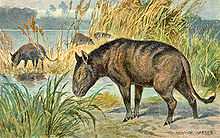
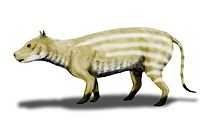
Merycoidodon would have somewhat resembled a pig in appearance, but had a longer body, at about 1.4 metres (4.6 ft), and short limbs. The fore limbs had five toes (although the first one was vestigial), while the hind limbs had four. Given the shape of the limbs, it is unlikely that the animals would have been able to run fast. Unlike modern ruminants, they had a full set of teeth, although the molars were adapted for grinding up tough vegetation. Notably, they had strong, and very striking, canines.[5]
The skulls of Merycoidodon have a pit in front of the eyes. Similar pits are found in the skulls of modern deer, where they contain a scent gland used for marking territory. Although Merycoidodon was not directly related to deer, it seems likely that it possessed a similar gland, which may imply that it, too, was territorial.[5] Oreodonts lived in large herds and moved about from place to place. They seem to have had a predilection for well-watered regions, where food was plentiful and succulent. The number of fossils found implies that, at one time, oreodonts were as plentiful in South Dakota as zebras are today on the serengeti plains.
Four specimens were examined by M. Mendoza for body mass and estimated to weigh 94.6 to 139.2 kg (209 to 307 lb).[6]
Fossil distribution
Fossils have been uncovered as far north as Alberta, Canada to Florida, Texas and Oregon in the United States.
Gallery
-
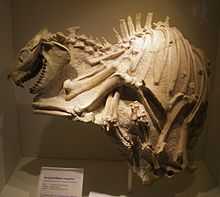
Merycoidodon gracilis from South Dakota
-
Merycoidodon gracilis from South Dakota. Skull
-
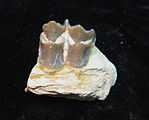
A tooth in a 3cm jaw fragment from Merycoidodon culbertsoni. Oligocene, Brule Formation, South Dakota, USA
References
- ↑ Stevens, M.S.; Stevens, J.B. (1996). "Merycoidodontinae and Miniochoerinae". In Prothero, D.R.; and Emry, R.J. (eds.). The terrestrial Eocene-Oligocene transition in North America. Cambridge: Cambridge University Press. pp. 498–573. ISBN 0-521-43387-8.
- ↑ PaleoBiology Database: Merycoidodon, basic info
- ↑ B. Lander. 1998. Oreodontoidea. In C. M. Janis, K. M. Scott, and L. L. Jacobs (eds.), Evolution of Tertiary mammals of North America 402-425
- ↑ L. Toohey. 1959. The species of Nimravus (Carnivora, Felidae). Bulletin of the American Museum of Natural History 118
- ↑ 5.0 5.1 Palmer, D., ed. (1999). The Marshall Illustrated Encyclopedia of Dinosaurs and Prehistoric Animals. London: Marshall Editions. p. 271. ISBN 1-84028-152-9.
- ↑ M. Mendoza, C. M. Janis, and P. Palmqvist. 2006. "Estimating the body mass of extinct ungulates: a study on the use of multiple regression". Journal of Zoology
- Benes, Josef. Prehistoric Animals and Plants. Pg. 219. Prague: Artua, 1979.
